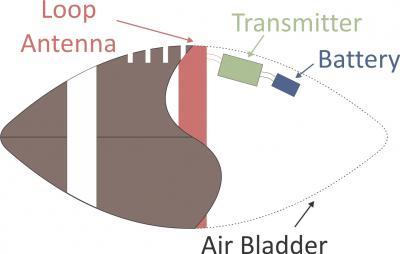It doesn't happen often but there are times when its unclear if a football crosses the goal line for a touchdown. If a quarterback attempts a sneak, for example, and the line pushes forward, he may be under too many players to be seen.
All the referees can do is pull people off and look at where the ball is, though there is no idea if that's where it was when his knee touched the ground. A Disney Research team, in collaboration from NC State and Carnegie-Mellon, developed a system that can track a football in three-dimensional space using low-frequency magnetic fields.
Previous attempts to design technology that tracks the position of a football have used high frequency radio waves, but these high frequency waves can be absorbed by players, making them less useful in pile-ups, when the ball is obscured by players, or thwarted by the complex physical environment of a football stadium. Low frequency magnetic fields don't interact very strongly with the human body, so they are not affected by the players on the field or the stadium environment.

Researchers have developed a system that can track a football in three-dimensional space using low-frequency magnetic fields. Credit: David Ricketts
The researchers designed and built a low frequency transmitter that is integrated into a football, and is within the standard deviation of accepted professional football weights. In other words, the football that has the built-in transmitter could be used in a National Football League game. Antennas, placed around the football field, receive signals from the transmitter and track its location.
But the researchers also had to address another complicating factor.
When low frequency magnetic fields come into contact with the earth – such as the playing surface – the ground essentially absorbs the magnetic field and re-emits it. This secondary field interacts with the original field and confuses the antennas, which can throw off the tracking system's accuracy.
"We realized that we could use a technique developed in the 1960s called complex image theory," says Dr. Darmindra Arumugam, lead author of the paper at NASA's Jet Propulsion Laboratory. "Complex image theory allows us to account for the secondary fields generated by the earth and compensate for them in our model."
"We're still fine-tuning the system, but our goal is to get the precision down to half the length of a football, which is the estimated margin of error for establishing the placement of the football using eyesight alone," says Dr. David Ricketts, an associate professor of electrical and computer engineering at NC State and senior author of a paper describing the research.





Comments